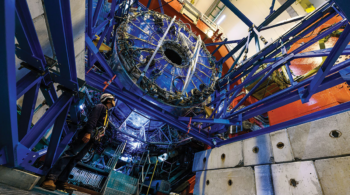One of the most fragile detectors for the LHCb experiment has been successfully installed in its final position. Installing the Vertex Locator (VELO) in the underground experimental cavern at CERN proved to be a challenging task for the collaboration.
The VELO is a precise particle-tracking detector that surrounds the collision point inside the LHCb experiment. At its heart are 84 half-moon-shaped silicon sensors, each connected to its electronics via a system of 5000 bond wires. These sensors are located close to the collision point, where they will play a crucial role in detecting b quarks.
The sensors are grouped in pairs to make a total of 42 modules arranged in two halves around the beamline in the VELO vacuum tank. A 0.3 mm thick aluminium sheet provides a shield between the silicon modules and the primary beam vacuum, with no more than 1 mm of leeway to the silicon modules. Custom-made bellows enable the VELO to retract from its normal position 5 mm from the beamline to a distance of 35 mm. This flexibility is crucial during the commissioning of the LHC beam.
The VELO project involves several institutes of the LHCb collaboration, including Nikhef, EPFL Lausanne, Liverpool, Glasgow, CERN, Syracuse and MPI Heidelberg. In particular, the sensor modules were constructed at the University of Liverpool, and Nikhef provided the special foil that interfaces with the LHC vacuum.





